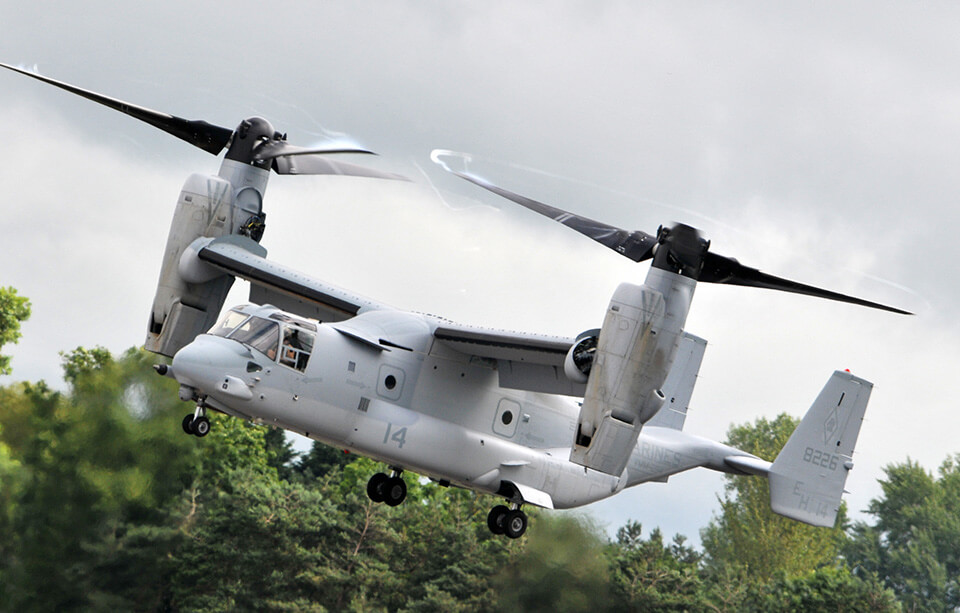When Bell-Boeing introduced the tiltrotor V-22 Osprey into Canada’s fixed-wing search-and-rescue aircraft replacement program, many saw it as a long shot.

Though company representatives tried valiantly to convince government and defense officials, as well as media, that the aircraft could perform both the search-and-rescue functions better than any of its competitors — flying at cruise speeds of 500 kilometers per hour and then landing on or hovering over the rescue site — the argument never took hold.
The Osprey’s sticker price and the nature of the fixed-wing CC-115 Buffaloes and H-model CC-130 Hercules the Royal Canadian Air Force (RCAF) was seeking to replace took the V-22 out of contention. In the end, the company opted not to respond the final request for proposals, and the competition was won in December by Airbus Defence & Space and its C295W.
Does the end of the fixed-wing SAR contest mean the end of the V-22 for Canadian consideration, or could it make a comeback at a later date, possibly for operations in the North?
Bell-Boeing has no active program in Canada for the Osprey, but at a January briefing at its production facilities in Philadelphia, company officials highlighted the V-22’s range and recent safety record, its ability to work in austere environments, without runways, and a program of record that is only just beginning to tap international sales.
With a standard combat radius of 796 kilometers, fully loaded, and a ferrying range of 4,926 km with one refueling, the Osprey has become a “workhorse” for the US Marine Corps and Air Force Special Operations Command (SOCOM) in current conflicts, said John Parker, the senior manager for the tiltrotor program.
Part of the appeal is the two-in-one capability of an aircraft that can reach cruising speeds over 500 km and altitudes of 3,000 meters, fully loaded, and the vertical lift and low maneuverability of a helicopter in a wide variety of conditions. “It gives you great flexibility in mission set capabilities across a very large spectrum,” said Parker.
The official program of record includes 360 for the Marines, 53 for SOCOM, and 48 for the US Navy’s carrier onboard delivery mission, as well as 17 for Japan, the first foreign military sale. Parker expected “sales to broaden,” by between 46 and 106 aircraft, as the program matures and moves toward a third multi-year contract in 2018.
While he wouldn’t name potential international customers, he did note that the V-22 can transport an F135 engine, so “any country with a blue water navy also accepting Joint Strike Fighter has been showing interest.”
A sign of their work rate, the 322 Osprey operating today recently surpassed 350,000 flight hours. And Bell-Boeing is already working with Rolls Royce to enhance the engines — more speed and altitude — and to introduce new capabilities such as precision guided munitions.
Not all aircraft are built to operate well in the Arctic, but Parker said other than the hydraulic system that requires on onboard heater, there were no limiting factors to operations in extreme cold.
Cost, however, would remain a concern for Canada. Multi-year contracts and the prospect of more international sales will undoubtedly help drive down the price, but “there is still a lot of sticker shock regardless,” Parker admitted. The unit flyaway cost in fiscal year 2014 was around $70 million, according to the Department of Defense.
The V-22 business case, however, is built performing tasks that would normally require at least two aircraft. “Think what a rotary wing is costing you, what a fixed-wing is costing you. Put those two together and you probably come up with pretty close to what we advertise,” Parker said.
At present, the RCAF operates a small fleet of four CC-138 Twin Otters from Yellowknife, Northwest Territories, that were acquired in 1970. The federal government expects to announce the winner of an in-service support contract in late February or early March that would include a life extension program. But the air force is also analyzing options for a utility transport aircraft to replace the Twin Otters after 2026.
The project, valued at up to $1.5 billion, would seek “a small fleet of aircraft to conduct utility airlift operations, maintenance and training,” according to the 2016 Defence Acquisition Guide. Among other high-level requirements, the RCAF wants an aircraft able to operate from semi-prepared or gravel-surfaced runways under harsh conditions in the Arctic and “the capability for autonomous operations while deployed, including a self-start capability after lengthy exposure to extreme Arctic temperatures.”
While a fixed-wing aircraft might again seem the preferred solution, novel alternatives are likely to emerge, suggesting a tiltrotor might not be far fetched. (Lockheed Martin, for example, has been floating the ability of its LHM-1 hybrid airship to operate across the North — it will have its first launch customer, Montreal-based Quest Rare Minerals, around 2019).
Long before he joined Boeing Defense, Space & Security as a lead for integrated logistics systems on the CH-147F Chinook program, Richard Comtois wrote a thesis while at the Canadian Forces College suggesting a Canadian-built tiltrotor might best achieve the “effects” Canada wanted in the Arctic. Despite skis and other attributes, fixed-wing aircraft could not project presence and reach as well as a tiltrotor, he found.









